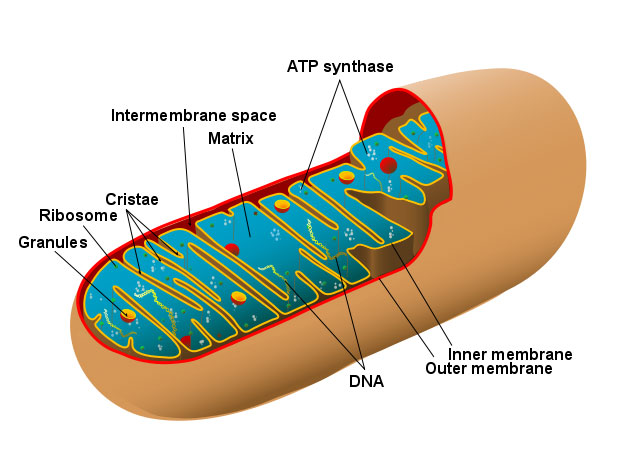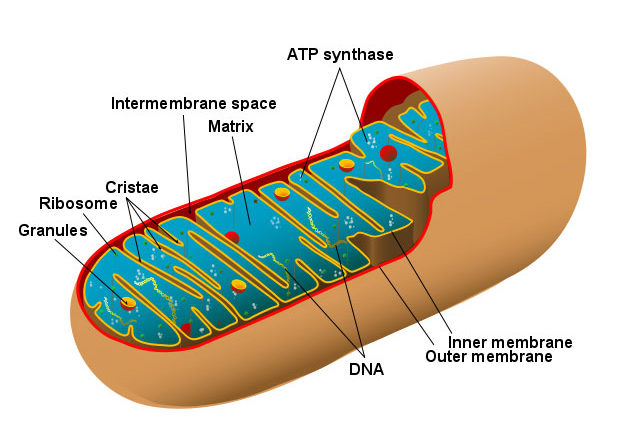Smithsonian blunders again!
When as venerable an institution as the Smithsonian puts out an article, one would expect it to have sound scientific information, even if we would disagree with the evolutionary interpretation of that information. Yet it gained infamy when it booted out researcher Dr Richard Sternberg merely for publishing a pro—intelligent-design article in the journal Proceedings of the Biological Society of Washington which he edited (see the documentary Expelled).
 So it is hardly surprising that they used a racist image at the top of the article “The Top Ten Daily Consequences of Having Evolved” on its website (as we have criticized). Furthermore, the ten examples themselves are such that they deserve comment in and of themselves. General diagram of a mitochondrion. Mitochondria vary in size and shape, from nearly spherical to long threadlike filaments.
So it is hardly surprising that they used a racist image at the top of the article “The Top Ten Daily Consequences of Having Evolved” on its website (as we have criticized). Furthermore, the ten examples themselves are such that they deserve comment in and of themselves. General diagram of a mitochondrion. Mitochondria vary in size and shape, from nearly spherical to long threadlike filaments.
1. “Our cells are weird chimeras”
The article discusses the origin of mitochondria, the ‘power plants’ of the cell, and treats the endosymbiosis theory as proven fact:
“Perhaps a billion years ago, a single-celled organism arose that would ultimately give rise to all of the plants and animals on Earth, including us. This ancestor was the result of a merging: one cell swallowed, imperfectly, another cell. The predator provided the outsides, the nucleus and most of the rest of the chimera. The prey became the mitochondrion, the cellular organ that produces energy.”
But there is no evidence that one cell can gobble up another, and the prey survive to reproduce in synchrony. Also, there are important genetic differences between mitochondria and any bacteria, and the mitochondrial DNA code is slightly different. If one code evolved into another, it would be like switching keys on a keyboard, and scramble the messages. Furthermore, mitochondria don’t make most of their own proteins, and even some they do make require subunits coded in the parent cells’ DNA. See also:
But despite the house of cards on which the endosymbiont dogma is built, the Smithsonian claims:
“Most of the time, this ancient symbiosis proceeds amicably. But every so often, our mitochondria and their surrounding cells fight. The result is diseases, such as mitochondrial myopathies (a range of muscle diseases) or Leigh’s disease (which affects the central nervous system)”.
However, these problems are caused by mutations in mtDNA, so they fail to produce enough energy, nothing to do with “fighting”. Rather, they are explainable as a consequence of the Fall; many evolutionists knock down a straw man of creation, arguing as if we believe that genetic perfection would be expected even now.
2. Hiccups
The article argues that hiccups are a vestige of the earliest air-breathing fish and amphibians. The just-so story is that they needed to be able to close the glottis, or entryway to the lungs, when underwater.
But hiccups are caused by an involuntary spasm of the diaphragm (‘synchronous diaphragmatic flutter’) which quickly sucks in air to the lungs. The glottis snapping shut is a reaction to this.
3. Backaches
Predictably, the article argues that our skeleton was originally evolved for going around on all fours, and bipedalism, for all its other evolutionary advantages, means that our back is in an unnatural position. The S curve of our spine is in this view an imperfect jerrybuilt solution.
But the S curve of the spine is actually ideal, and humans are actually able to lift a higher percentage of their bodyweight than gorillas, whose spines do not have the S curve. Evolutionist orthopedic surgeon Paul Williams even designed exercises to reduce the lordosis curve in the spine to help reduce backaches. But these were often unsuccessful, often causing people to resort to surgery. But physical therapist Robin McKenzie discovered that proper posture that restores the lordosis often reduces or even eliminates back pain. See the following related articles:
4. Unsupported intestines
In an entry related to the previous one, the article argued that bipedalism meant that our intestines are not as well supported as they would be if we still went around on all fours, and they cite hernias as a major consequence. But this assumes that we originally were quadrupeds. It is equally convincing to see the problems as a consequence of weak abdominal muscles due to insufficient exercise, etc.
5. Choking
Choking is blamed on our upright posture, which puts both the esophagus and trachea in a vertical position, so food or liquid can sometimes go down the wrong tube. The article gives some lip service to the need for speech, but that is a key reason that our versatile mouth parts are integrated with the air flow by the arrangement. It also enables the nose and mouth to act as alternative breathing ports, and allows us to eat and breathe at the same time. For more information, see:
6. Furlessness
In one of the most contrived entries, furlessness is said to be a consequence of evolution. But there’s no evidence that we ever had fur, and the entry basically amounts to ‘Gee, wouldn’t it be nice if we had fur like lots of other mammals?’ And why would natural selection favour the loss of something that’s allegedly useful? It can’t be because humans began in tropical Africa, as the story goes, because other African mammals, including primates, have fur.
7. Goosebumps don’t help.
Goosebumps are not functionless; they do make a difference even with our small hairs, in trapping a layer of air. Also, the muscles help squeeze oil on to the skin. The hairs help stop the oil glands being clogged.
Related to the previous entry, the author complains that our lack of furlessness makes goosebumps a useless leftover. But surely, if it had been completely useless, we wouldn’t have them anymore, because evolution would have gotten rid of them too in the evolutionists’ view. In reality, even the small amount of hair we have, when it stands on end, helps to conserve body heat by trapping more air. Furthermore, the book Greatest Hoax on Earth? points out:
“However, goosebumps are not functionless; they do make a difference even with our small hairs, in trapping a layer of air. Also, the muscles help squeeze oil on to the skin. The hairs help stop the oil glands being clogged. The muscle contractions themselves generate heat, of which more can be generated by shivering. The whole process is called piloerection. Body hairs provide extra sensitivity to touch, and also help in the cooling process by keeping perspiration in an even layer rather than dripping off. The fact that men tend to perspire more (due to higher metabolic rate) is one reason that men have more body hair than women.”
8. Brains squeeze our teeth
The idea that wisdom teeth are a useless evolutionary leftover has been repeated over and over, but the simple fact remains that compacted wisdom teeth are only a problem in the Western world where we don’t wear our teeth down as much, or exercise our jaw as much, because our food is mostly soft and processed. In less-developed areas, the rougher diet causes people’s teeth to wear more, and their jaws are more developed, because of the greater exercise, so there is room for the wisdom teeth. Furthermore, evolution has resulted in unnecessary removal of wisdom teeth which were doing no harm. See:
9. Obesity
The author claims that obesity is a problem because we evolved to store fat for times of famine, etc., and we haven’t lived in relative affluence for long enough for this survival mechanism to ‘switch off’. And to cite this as a consequence of evolution is very Western-centric, given that large populations struggle to get enough food to survive. In such cases, the body’s abilities to store energy in the form of fat reserves are greatly needed. Blaming gluttony on evolution seems very self-serving.
10. ?
Propaganda pieces like this actually show how weak the evidence for evolution is.
The article says that there are ten consequences, but doesn’t bother to actually give a tenth. Instead, it bluffs by claiming that there could be 100 such examples, and gives passing mention to male nipples and blind spots. Neither of these is an actual evidence of evolution, as we have amply shown. See:
Propaganda pieces like this actually show how weak the evidence for evolution is. Out of the ten things this author chose, half of them were closely related to others, and the tenth thing wasn’t even a real example. The explanations were so shallow that ‘it’s a piece for laypeople’ doesn’t even begin to be an excuse.Further reading




